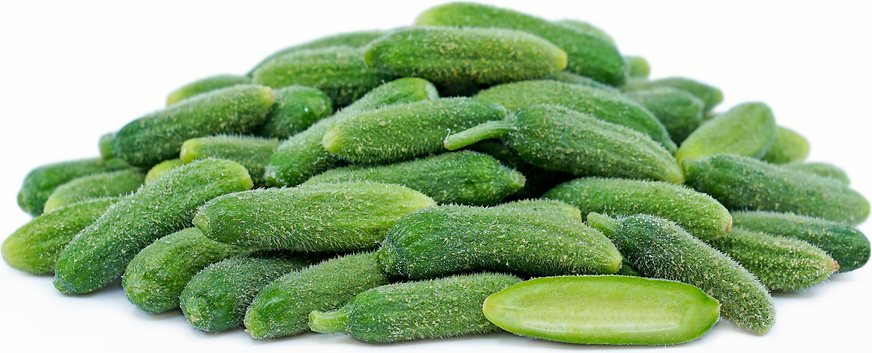


Cornichon Cucumbers
Estimated Inventory, 4 lbs : 0
This item was last sold on : 06/06/25
Description/Taste
Cornichons are very small fruits, averaging 2 to 7 centimeters in length, and have a cylindrical, narrow, and straight to slightly curved shape with rounded ends. The skin is firm, bumpy, and dark green, sometimes covered in small, soft spines. Underneath the surface, the flesh is crisp, aqueous, pale green, and is either seedless or may contain a few small seeds. Cornichons are known for their crunchy, juicy consistency and have a tart, vegetal flavor.
Seasons/Availability
Cornichons are available in the summer through the fall.
Current Facts
Cornichons are botanically a part of the Cucurbitaceae family and are varieties that are harvested early for their tart flavor, small size, and crunchy consistency. The name Cornichon roughly translates from French to mean “little horn” and can be used to describe both the fresh, small cucumbers sold in local markets and also the pickled, preserved versions. There are multiple cucumber varieties generally labeled as Cornichons in French markets, with the most popular cultivars, including Parisienne Cornichon de Bourbonne, Parigno Cornichon, and Fin de Meaux. Cornichons are also known as Gherkins outside of France, and the small fruits are increasing in global popularity as a favored variety to make bite-sized pickles.
Nutritional Value
Cornichons contain small amounts of vitamin C, which is an antioxidant that can protect the body against external aggressors by boosting the immune system. The fruits also contain some potassium, iron, magnesium, folate, and phosphorus.
Applications
Cornichons can be consumed fresh, but they are most popularly used to make pickles. The small fruits are salted overnight, placed in a jar, and are then covered in a hot mixture of vinegar, water, and salt. Many aromatics, spices, and herbs can also be added to flavor the salty, tart fruits, and once sealed, the jarred mixture is stored for at least three weeks to ferment. Pickled Cornichons are widely used in European cuisine, especially in French dishes, and can be eaten straight, out-of-hand on appetizer plates with cheeses, smoked meats, and nuts. They can also be minced into deviled eggs, chopped and tossed into potato and green salads, sliced and layered into sandwiches and sliders, or stirred into beef stroganoff. In addition to chopping and slicing, Cornichons are commonly blended into sauces such as tartar and are served with fried seafood. The small pickled fruits can also be found in steak tartare recipes, beef roulade, or served as an accompaniment to raclette cheese melted over meats, vegetables, and potatoes. Cornichons pair well with meats such as bacon, prosciutto, bologna, beef, poultry, and fish, herbs such as thyme, bay leaves, cloves, and tarragon, white vinegar, onions, eggs, and cheeses such as gruyere, cheddar, and raclette. The fresh cucumbers will keep 1-2 weeks when stored in the crisper drawer of the refrigerator. Once pickled, the preserved fruits will keep 6-12 months in the refrigerator.
Ethnic/Cultural Info
In France, Cornichons were planted in the Potager du Roi, which is the official garden of the Palace of Versailles. The twenty-three-acre garden is made up of twenty-eight smaller plots of land, and in the modern-day, the garden is maintained by the French National Landscape Architecture School. Potager du Roi is home to over seven hundred different species of fruit and vegetable varieties, and Cornichons were first grown in the gardens and used in French cuisine during the reign of King Louis XIV. One of the most well-known uses for pickled Cornichons in France is to provide a tangy crunch to charcuterie boards. The name charcuterie stems from two French words that roughly translate to mean “cooked flesh” and was initially used to describe butcher shops in France that sold pork products. Over time, the name was also given to appetizer plates that featured small amounts of smoked meats and was created to reduce the amount of wasted food. Charcuterie boards are still frequently used at restaurants today and have become a trending appetizer served with cheeses, meats, pickles, olives, and nuts.
Geography/History
Cornichons are native to India and quickly spread across Europe and Africa, where they were primarily grown for pickling. The cucumbers were integrated into French cuisine in the 1700s and were extensively cultivated in local gardens, over time creating many new French varieties of the small fruit. Cornichons were also introduced to the United States in the late 1800s where they became generally known as pickles or Gherkins. Today Cornichons are primarily found in pickled form throughout France, but they can also be found fresh in select local markets for culinary use. Cornichons are also found throughout Europe under the name Gherkin and are especially popular in the United Kingdom, Ireland, and Germany. Outside of Europe, Cornichons can be found in limited quantities in the United States, Canada, Australia, Asia, Africa.
Recipe Ideas
Recipes that include Cornichon Cucumbers. One
| Seasons And Suppers |
|
Cornichon Tarragon and Mustard Chicken |
| The Spruce Eats |
|
Classic French Cornichon Pickles |




